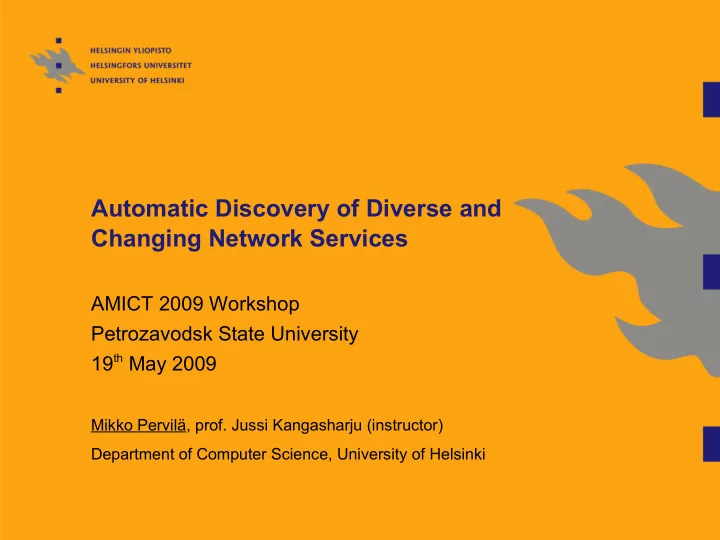

Automatic Discovery of Diverse and Changing Network Services AMICT 2009 Workshop Petrozavodsk State University 19 th May 2009 Mikko Pervilä, prof. Jussi Kangasharju (instructor) Department of Computer Science, University of Helsinki
Presentation Outline Goal: the ratio of common-mode (CMF) to normal failures Most common causes for CMFs Describe a work in progress measurement framework Some self-healing also a possibility Data suitable for Bayesian analysis Main problem: the environment keeps changing Fixes: automatic discovery, distributed monitoring
CMFs – The Basics From Fault Tolerance by Design Diversity: Concepts and Experiments by A. Avižienis and J. Kelly, 1978: N -fold computation in time, hardware, and software Repetitions from (1T / 1H / 1S) to ( X T / Y DH / Z DS) D is for diversity M -plex faults affect M out of the N computations The faults may either be independent or related Their cause may either be operational or by design
CMFs – Well known in early CS Dionysius Lardner, Babbage's Calculating Engine, in the Edinburgh Review , July 1834: “The most certain and effectual check upon errors which arise in the process of computation, is to cause the same computations to be made by separate and independent computers; and this check is rendered still more decisive if they make their computations by different methods.”
CMFs – What is in a name? “Common-mode failures” more common than “ M -plex” First occurrence from 1930 (?) in the Journal of American Ceramic Society by J. Otis Everhart “The common mode of failure in the autoclave is by crazing [...] The common mode of failure during freezing is by spalling, [...]” Physical stress and temperatures seem to be reoccurring themes
CMFs – How common are they today? Nvidia GPU Failures Caused By Material Problem, Sources Claim. Tom's Hardware, Aug. 26 th , 2008 $200 million for repairs Microsoft Zune 30 GB meltdown, Dec. 31 st , 2008 Bad leap year parsing code causes device lockups Enter the Poorly Designed MLC, AnandTech, Sep. 8 th 2008 Some SSD controllers cause random 1 second writes Seagate firmware fix bricks Barracudas, Jan. 21 st , 2009 Firmware fix for 1 TB drives causes 500 GB drive failures
CMFs – User reports are problematic The problem with these reports is their credibility Reported by home users, enthusiasts, and hardware sites Scientific background of the reporters a question Methodology? Bias? Repeatability? Product failure rates are business secrets Data sets seldom available
CMFs – Measurement goal Study related downtime; Data mining, Bayesian models www.cs.helsinki.fi http https webmail cpu temp power1 disk smtp.cs.helsinki.fi smtp smtps cpu temp power1 hdd1 downtime
Nagios – The sentinel service Basic idea: run input / output checks against services Versatility: checks run by plug-ins; any program code Nagios handles scheduling and interleaving checks Output outside given parameters causes a notification Primary focus: network services Distributed monitoring catches local services Fan speeds, temperatures, SMART attributes for storage, …
Nagios – Network services Monitoring the CS Dept. network is challenging New hosts and services come and go Research groups administer their own hosts Partial solution: Nmap Security Scanner Scans IP blocks, discovers services Nmap produces XML output Nmap → Nmap3Nagios → Nagios Our open source tool for configuring Nagios
Nagios – Local services Distribute local Nagios daemons Run checks against local services Nagios' client-server tunnel NSCA reports back Results may be stale if workstation is shut down smtp.cs.helsinki.fi central Nagios server ssl nsca client nsca server hdd smtp external power command imap cpu file temp Nagios Nagios daemon daemon results
Nagios – Self-healing When a service malfunctions Plugin notices abnormal output Nagios notifies administrators with mail, SMS, … Nagios can also call external event handlers Event handlers perform scripted actions E.g., restart services, analyze log files Requires special privileges But very flexible
Nagios – Problems For administrators, fixing problems is a priority Acknowledging Nagios secondary Planning downtime tertiary, or even less Nagios' GUI very old school Administrators can not redefine hosts or services Not integrated with local issue trackers (yet) Many alternative GUIs, none really good for us
Nagios – Problems cont'd Nagios is a delicate instrument It detects failures usually invisible for human users Scheduled backup runs Automatic software upgrades Service dependencies complex Manual work still necessary Where should dependencies be stored? NACE tool uses SNMP fields for this Dual-booting between Windows and Linux
Conclusions Common-mode failures seem very common Monitoring failures can be done, requires work Keeping up with administrators very difficult Working on a toolkit, will publish data
Questions, Comments? Nmap3Nagios tool available from http://www.cs.helsinki.fi/u/pervila/Nmap3Nagios/ Other tools will follow pervila@cs.helsinki.fi
Thanks - Спасибо!
Recommend
More recommend